Abstract
Operative delivery requires the use of a vacuum extractor; obstetricians can choose the appropriate vacuum extractor to make the delivery process smoother and safer. However, there is no biomechanical literature focused on the imposed effects of a vacuum extractor prepared with different materials and vacuum pressure on the fetal head during the process of delivery. Therefore, we first established and performed the finite element analytical model to explore the influences of vacuum extractors manufactured from different materials on the fetal head under various extractive pressures. The model of the vacuum extractor was designed as a hemispherical shape, and the material of the vacuum extractor was composed of silicone rubber and stainless steel for comparison. Four different vacuum pressures (500 cm H2O, 600 cm H2O, 700 cm H2O, and 800 cm H2O) were applied as the factors for investigation. The reaction force on the fetal head, von Mises stress of vacuum extractor, and von Mises stress on the skull of fetal head were measured and analyzed to evaluate the effects. The results revealed that subtle divergent influences of different vacuum pressures were observed, and the stainless-steel vacuum extractor induced a larger reaction force (358.04–361.37 N), accompanied with stress (13.547–13.675 MPa), on the fetal head than non-metallic or relatively softer materials. The results provide a reliable basis for selecting proper vacuum extractor during operative delivery to avoid obstetrical complications, such as scalp scratch, cephalohematoma and even intracerebral hemorrhage.
1. Introduction
Operative delivery is an important lifesaving obstetric technique in clinical delivery units, wherein obstetrical physicians can perform a smoother and safer delivery with the help of a vacuum extractor and forceps [1]. However, using these tools for assistance in operative vaginal delivery still has related risks. Taking the vacuum extractor as an example, mothers may have a relatively high chance of experiencing fourth-degree perineal lacerations [2], and fetuses have higher chance of suffering from caput succedaneum, cephalohematoma, subgaleal hematoma, scalp laceration, and even intracranial hemorrhage [3].
Currently, in accordance with the clinical demands, vacuum extractors with a great variety of designs fabricated from different materials are available on the market [4]. Vacuum extractors are made of different materials, such as soft (e.g., silicone rubber) and hard (e.g., metals) materials [5]. According to the clinical experience of application, vacuum extractors made of soft materials are easy to use and infants are less likely to be injured, compared with vacuum extractors made of metal materials for extraction [6]. Moreover, if the vacuum pressure is too high, the use of the vacuum extractor may still cause injuries to the puerpera and newborns [7]. Although the above is known clinically, there is still no associated biomechanical research that can clearly monitor the stressed influences of vacuum extractors manufactured from diverse materials and at different vacuum pressures.
Childbirth, or labor, is a seemingly calm but crisis-rich process; even with the agreement of the institutional review board and informed consent from the mother, clinical experiments on the fetus during the birth process may induce accidental damage or incomplete data. Observing the imposed force exerted by the vacuum extractor under the attractive pressure on the fetal head during the delivery process is quite difficult in clinical practice. Therefore, some scholars used a finite element analysis to evaluate the influences on the fetal head during delivery in the past [8]. For example, observation of the distribution of pressure on the fetal head at the first stage of labor and analysis of the biomechanical effects of placing the vacuum extractor in different positions were all performed by way of finite element analysis, and even the finite element analysis could be used to evaluate the effects of using forceps with different angles on the fetal head [9,10,11]. Therefore, although exploring the influences of external force on the fetal head during operative delivery with vacuum extractor in clinical practice is not easy to implement, the method of finite element analysis could be executed to simulate the real clinical obstetrical situation exactly and to investigate the biomechanical impacts of the attractive force projected to the fetal head in the delivery process efficiently.
Based on the previous literature, though there have been some studies on the biomechanical analysis of forceps or vacuum extractors during delivery, there is still no further thorough biomechanical research focused on the materials and the pressures of vacuum extractors. Therefore, we firstly utilized the finite element analytic method to investigate and verify the divergent influences of vacuum extractors made of different materials on the fetal head under various extractive vacuum pressures. The results of this study could provide a dependable biomechanical basis as a crucial reference for clinicians to reduce or avoid the incidence of fetal head injuries and other obstetric complications while choosing vacuum extractors during operative delivery.
2. Materials and Methods
2.1. The Simulation Geometry Model
In this study, to investigate the influences of using different materials of vacuum extractors and different vacuum pressures, finite element models of vacuum extractor and fetal head were established, and the design of vacuum extractor model was mainly hemispherical. According to the previous literature [12], a cup of 5 cm diameter is suitable for nearly all deliveries, so the vacuum extractor model used herein was a hemispherical vacuum extractor with a diameter of 5 cm (Figure 1). This three-dimensional (3D) model of the vacuum extractor was plotted, using 3D computer graphics software SolidWorks (SolidWorks 2016, Dassault Systems SolidWorks Corp, Waltham, MA, USA). In addition, because the effect of vacuum extractor on the fetal head was to be evaluated, a fetal head model was established. The fetal head model was a computer model established mainly based on previous research [11,13]. The fetal head computer model was mainly established by referring to the fetal head anatomical model based on the following parameters of a full-term fetus: the fetal head circumference is about 35 cm, the biparietal diameter is about 9.5 cm, the occipitofrontal diameter is about 12 cm, and the occipitomental diameter is approximately 13.5 cm in size. In addition, the fetal head was divided into the structures of the scalp and skull, which were a 1 mm-thick scalp and 2 mm-thick skull, respectively. Therefore, the computer models used herein were mainly divided into three parts, namely, the fetal head scalp, fetal head skull, and vacuum extractor (Figure 1). The proper location of the flexion point for vacuum-assisted delivery is found to be located about 3 cm anterior to the posterior fontanelle along the midline of the sagittal suture of the fetal head [14]. The established model was imported into finite element analysis software ANSYS Workbench (ANSYS Workbench 18.0, ANSYS, Inc., Canonsburg, PA, U.S.A.) for the finite element analysis.
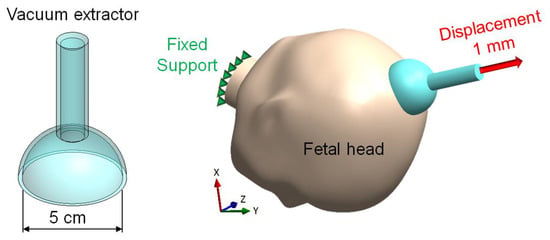
Figure 1.
The vacuum extractor plotted herein and the finite element analysis model of using a vacuum extractor on the fetal head.
2.2. Loading Conditions and Boundary Conditions
In this study, we mainly simulated the force exerted by different vacuum extractors and different vacuum pressures on the fetal head. Therefore, in this study, we adopted a boundary condition and two different load conditions. The first load condition was to simulate the vacuum pressure in the fetal head area that provides the head extraction force when the vacuum extractor extracts the fetal head. According to the previous literature [12], the operating vacuum pressure near all ventouses is 500–800 cm H2O (0.6–0.8 kg/cm2; 60–80 kPa). To explore the influences of different vacuum pressures, four different vacuum pressures were selected as the factors to be investigated—500 cm H2O, 600 cm H2O, 700 cm H2O, and 800 cm H2O. The area applied with the boundary condition setting of vacuum pressure was mainly the inner side of vacuum extractor (Figure 2). The second load condition simulates the situation of pulling outward by the vacuum extractor. The operation mode herein applies a 1 mm displacement in the Y direction to the end of the vacuum extractor, using displacement control (Figure 3). In addition, as for the boundary conditions herein, the neck of fetal head was set as a fixed area (the area marked with green color in Figure 1), and the displacement of the X axis, Y axis, and Z axis in this area was set as 0.
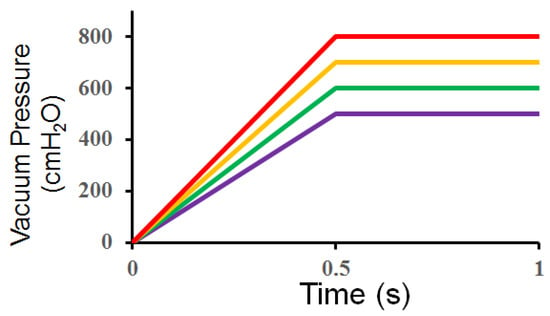
Figure 2.
Magnitude of load conditions used in this study. Vacuum pressure applied to the crown area of fetal head.
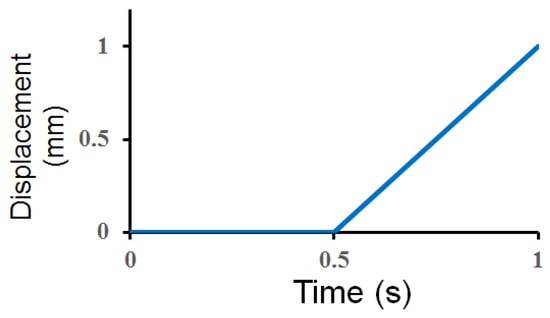
Figure 3.
Magnitude of load conditions used in this study. Amount of displacement applied to the vacuum extractor.
2.3. Material Properties of the Model
The research model comprised three parts, namely the scalp of the fetal head, skull of the fetal head, and the vacuum extractor. The materials used for the vacuum extractor were mainly silicone rubber and stainless steel, which are commonly used clinically. The defined properties of materials used herein were mainly obtained from previous studies by other scholars [15,16,17]. All materials were assumed to be homogeneous, isotropic, and linear elastic. Therefore, two independent parameters (Young’s modulus and Poisson’s ratio) were used to express the properties of the materials. Table 1 shows the values defined for the properties of the materials used in the simulation herein. In addition, the mesh element used in the computer model of finite element analysis herein was a tetrahedral mesh (Figure 4). After the convergence test, the model reached the 5% stop criteria of convergence test [18], so the finite element mesh model used in this study is reasonable (the mesh size used herein was 4 mm). The computer finite element analysis model adopted herein had 131,198 nodes and 65,270 elements.

Table 1.
Material properties setting in this study [15,16,17].
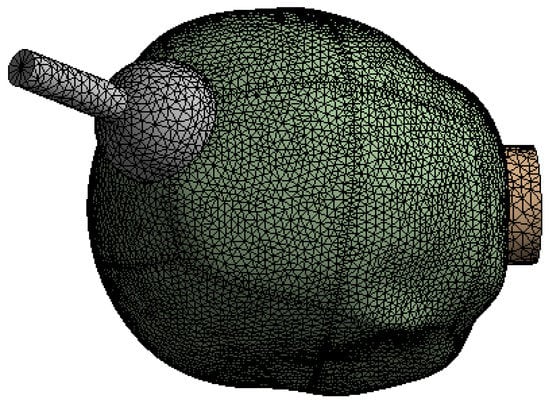
Figure 4.
Mesh model, which is the finite element analysis model used herein.
After the finite element analysis, the main observation indices herein were the reaction force at the fixed end, von Mises stress on vacuum extractor, and von Mises stress on the fetal head skull (among which the value of the von Mises stress was defined as = ), where σ1, σ2, and σ3 represent the principal stress along the three axes). According to these observation indices, the biomechanical effects of the vacuum extractors fabricated from different materials and at different vacuum pressures on the fetal head were investigated.
3. Results
In this study, after the finite element analysis, the reaction force as well as the corresponding stress distribution on the vacuum extractor and fetal skull with the neck of fetal head as the fixed end were obtained. Figure 5 shows the numerical magnitude and stress direction of the reaction force on the fetal head with different materials of vacuum extractors and under different vacuum pressures. Table 2 shows the magnitude of the reaction force and its components in each axis. With the increase in vacuum pressure, the magnitude of the reaction force increased slightly. In addition, when using vacuum extractors fabricated from different materials, the numerical values of reaction force differed significantly. On the whole, when silicone rubber was used as the material of vacuum extractor (12.229–15.064 N), the reaction force was smaller, compared with using stainless steel (358.04–361.37 N).
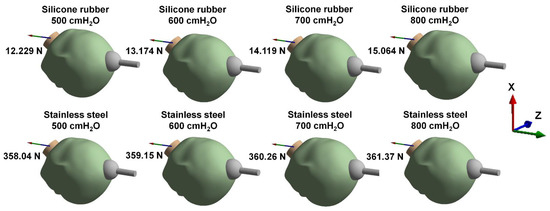
Figure 5.
Direction of reaction force on the fetal head.

Table 2.
Magnitudes and components of reaction force.
Figure 6 mainly exhibits the distribution of von Mises stress on vacuum extractors with different materials of vacuum extractors and under different vacuum pressures. The results showed that the greater the vacuum pressure applied, the greater the von Mises stress on the vacuum extractor. In addition, when different materials were used for the vacuum extractor, the magnitude of von Mises stress on the vacuum extractor differed significantly. When the material used for the vacuum extractor was silicone rubber (0.5858–0.9510 MPa), the von Mises stress on the vacuum extractor was smaller, compared with using stainless steel.
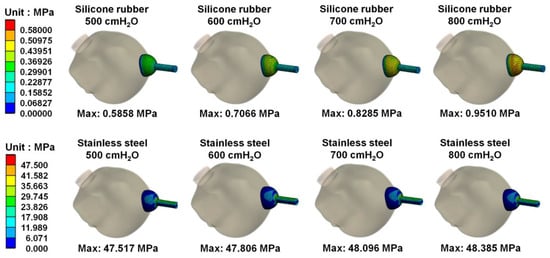
Figure 6.
Distribution of von Mises stress on the vacuum extractor.
Figure 7 reveals the von Mises stress distribution on the fetal head skull measured under different vacuum extractor materials and pressures at different times (t = 0.25 s, t = 0.5 s, t = 0.75 s and t = 1 s). As the pictures show, the effects of pressures at the time from 0 to 0.5 s mainly indicate the vacuum pressure within the suction device, and the effects of pressures at the time from 0.5 to 1 s principally imply the extraction process of the vacuum extractor on the fetal head caused by pulling out. When the time t = 1 s, the results show that the von Mises stress in the area on the fetal head skull extracted by the vacuum extractor showed relatively greater stress with the increasing vacuum pressure when silicone rubber was used as the material of the vacuum extractor. Furthermore, the maximum stress occurred near the center of the sphere part on the vacuum extractor. In addition, when stainless steel was used as the material of the vacuum extractor, the von Mises stress on the vacuum head skull increased slightly with the increase in the vacuum pressure; moreover, there was high stress distribution on the vacuum head skull in the outer area of the vacuum extractor. When silicone rubber (2.4755–4.0156 MPa) was used as the material of the vacuum extractor, the value of von Mises stress on the fetal head skull was smaller, compared with using stainless steel (13.547–13.675 MPa).
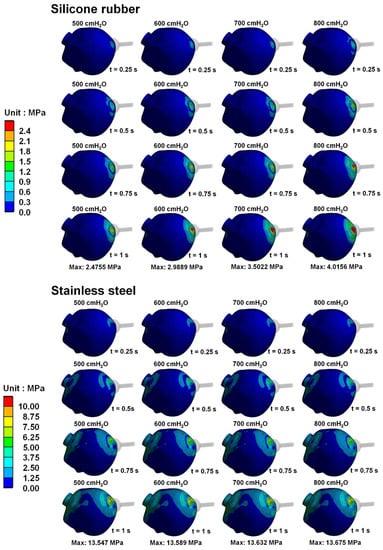
Figure 7.
Distribution of von Mises stress on the skull measured under different vacuum extractor materials and pressures at different times.
4. Discussion
In this study, we successfully the performed finite element analysis to explore the influences of vacuum extractors fabricated from different materials and under different vacuum pressures on the fetal head during the delivery process. To date, there is no detailed mechanical basis for investigating the influences of using vacuum extractors made from different materials in clinical practice. The results of this study could provide a reliable reference basis for clinical obstetricians for choosing the material and magnitude of pressure of the vacuum extractor when they are needed for operative delivery. In addition, based on these results, the complications, including head deformation, scalp abrasion, even cephalohematoma, and intracerebral hemorrhage caused by the vacuum extractor during operative vaginal deliveries, could also be reduced and alleviated.
According to the observation of reaction force herein, when the vacuum extractor was made of stainless steel, the fixed end of the fetal head neck was subjected to a relatively large reaction force. The main reason can be explained by the content put forward in the textbook, Mechanics of Materials [19]. F = σA and σ = Eε, where σ is the stress, F is the external force, A is the cross-sectional area, E is the Young’s modulus, and ε is the strain. Therefore, it can also be expressed as F = EεA. When the displacement changes given are consistent and the stressed section is the same, the external force is proportional to Young’s modulus. Therefore, as Young’s modulus of the stainless steel used in this study was 200,000 MPa and that of the silicone rubber was 10.3 MPa, stainless-steel vacuum extractors made the fixed end of fetal head neck subject to a relatively large reaction force. In addition, by observing the influences of different vacuum pressures on the reaction force on the fixed end of fetal head neck, when a greater vacuum pressure was applied, the reaction force on the fixed end of the fetal head neck increased slightly. According to the textbook, Mechanics of Materials [19], the mechanical analysis description for spherical shells indicates that F = σ(2πrt) = p(πr2), where σ is the stress on the spherical shell, r is the inner radius of spherical shell, p is the vacuum pressure, and t is the wall thickness on the vacuum extractor. Hence, the reaction force on the fixed end of fetal head neck is proportional to the vacuum pressure. The greater the vacuum pressure, the greater the reaction force on the fixed end of the fetal head neck.
By observing the stress on the vacuum extractor, the greater the vacuum pressure, the greater the von Mises stress on the vacuum extractor. Because σ(2πrt) = p(πr2), the stress on the spherical shell of vacuum extractor was σ = pr/2t. Therefore, when the vacuum extractor had a fixed shape, r and t in the formula were fixed values, so the stress on the vacuum extractor was proportional to the vacuum pressure. Hence, the greater the vacuum pressure applied, the greater the von Mises stress on the vacuum extractor. In addition, when different materials were used for the vacuum extractor, the von Mises stress on the vacuum extractor was based on σ = Eε; when the given displacement was the same, stress (σ) was proportional to Young’s modulus (E). Therefore, using stainless steel as the material of vacuum extractor caused relatively high stress (47.517–48.385 MPa) on the vacuum extractor. Although using stainless steel had higher stress, compared with using silicone rubber, the yield stress value of stainless steel was approximately 700 MPa [20]. In this study, when stainless steel was used as the material of vacuum extractor, the result of stress value on the vacuum extractor was much lower than 700 MPa. Therefore, using stainless steel as the material of vacuum extractor does not cause permanent deformation of the vacuum extractor, while using silicone rubber as the material is prone to deformation.
In addition, by observing the stress on the simulated fetal head skull structure, when silicone rubber was used as the vacuum extractor material, the stress on the fetal head skull was subjected to the attraction by the vacuum extractor. This would cause the fetal head skull structure to be greatly deformed at the center of the sphere on the vacuum extractor, so there would be relatively high stress, and the stress value would be greater with an increase in vacuum pressure. In addition, when stainless steel was used as the vacuum extractor material, because metals have relatively high strength, there was relatively high stress in the outer area of the vacuum extractor when pulling out the infant during delivery. In addition, when stainless steel was used as the material, the value of von Mises stress on the fetal head skull was larger, compared with using silicone rubber. The main reason is that for the load conditions, when the same displacement was applied and stainless steel was used as the vacuum extractor material, the structural deformation of the fetal head skull was relatively large, owing to the high strength and small deformation of stainless steel, so the stress value on the fetal head skull was relatively high when using stainless steel. Therefore, the previous literature indicates that using non-metallic vacuum extractors can reduce fetal skull injury [21]. The reason may be that using non-metallic vacuum extractors have relatively low stress on the head skull.
There are some limitations in the finite element analysis. In this study, to evaluate the data on reaction force, among the boundary conditions, the fetal head neck was set as a fixed area, so such a setting would possibly cause the numerical results of reaction force in this study to be even larger than the actual situation. The model structures of vacuum extractors fabricated from two different materials evaluated herein were simulated with the same model structure shape, mainly owing to the need to evaluate the influences of different materials. To avoid the influences of different shapes, we herein used the same model for vacuum extractors fabricated from silicone rubber and stainless steel. In addition, the structure of fetal head model was simplified, and only two structures—the scalp and the skull—were established. This simplification could simply evaluate the model we want to analyze so that the research results could focus on identifying the differences in influences of the factors we want to observe and investigate. In addition, this study simplified many structures and organs within the pelvic cavity during the pregnant status, compared with other, previous computer models [22]. This simplification can not only reduce uncertain and overly complicated results caused by too many mutation parameters, but also reduce the resistance of pregnant women to the fetal head during delivery. However, the data of this study are slightly different from the actual data; such a simplification does not affect the theme trend of this study.
With the help of the method of the finite element analysis, the results adopted in this study revealed that the stainless-steel vacuum extractor with a higher Young’s modulus has a greater reaction force and stress on the fetal skull than the materials with a lower Young’s modulus; the attractive pressure of vacuum extractor on the fetal head still has a slight upward trend as the attractiveness is raised. Although the values obtained from this analysis are still different from the actual clinical situation of delivery, these results more clearly reflect the obvious trend of the actual situation and could be further evaluated and studied in the design of vacuum extractor accompanied with many types of research on vacuum extractors as a reference or to be discussed in the future, such as different types of vacuum extractors and external forces given to vacuum extractors in different directions. All these research topics mentioned above could be explored and investigated. The results of this study also provide an assured biomechanical basis for obstetricians and gynecologists to select appropriate vacuum extractors and apply conscious suction force during operative delivery, leading to the reduction and avoidance of major associated complications caused by these instruments to improve the overall quality of delivery.
5. Conclusions
In this study, finite element analysis was firstly conducted to explore the divergent effects of distinct vacuum extractor materials and different vacuum pressures on the fetal head during vacuum-assisted operative delivery from the biomechanical perspective. The results showed that the fetal head is exposed to relatively larger stress under the larger vacuum pressure with only a slight upward enforcement. More importantly, the higher Young’s modulus of the material of the vacuum extractor, such as stainless-steel, lead to greater attractive reaction force and stress subjected to the fetal head, which may cause subsequent damages. Therefore, according to the deductive results of the finite element analytic methods, it provides the reliable suggestion that the obstetricians should choose the vacuum extractor made of non-metallic, relatively softer or more elastic materials, such as silicone rubber with reasonable attractive force, during the whole clinical process of vacuum-assisted delivery to avoid complications, such as scalp scratch, cephalohematoma, deformation of the fetal head and even intracerebral hemorrhage caused by powerful external reinforced force while simultaneously improving the safety and quality of medical care of the mother, fetus or newborn during the entire process of operative vaginal delivery.
Author Contributions
Conceptualization, Y.-H.C. and K.-M.S.; methodology, K.-C.S.; data curation, M.-T.T. and K.-C.S.; writing—original draft preparation, Y.-H.C., C.-K.L. and C.-C.C.; writing—review and editing, Y.-H.C., K.-M.S. and K.-C.S. All authors have read and agreed to the published version of the manuscript.
Funding
This research received no external funding.
Institutional Review Board Statement
Not applicable.
Informed Consent Statement
Not applicable.
Data Availability Statement
We have preprinted this research on the preprint platform Research Square. (DOI: https://doi.org/10.21203/rs.3.rs-543589/v1, accessed on 20 August 2021).
Acknowledgments
We would like to thank Taichung Veterans General Hospital and Hungkuang University (TCVGH-HK1088001 and TCVGH-HK1098002) in Taiwan and the 3D Printing Research and Development Group of Taichung Veterans General Hospital for building the simulation computer model of this study. This research was also supported in part by the following grants from the Tri-Service General Hospital (TSGH-D-110137).
Conflicts of Interest
The authors declare no conflict of interest.
References
- Cunningham, F.; Leveno, K.; Bloom, S.; Spong, C.Y.; Dashe, J. Williams Obstetrics, 24e; Mcgraw-Hill: New York, NY, USA, 2014. [Google Scholar]
- Gurol-Urganci, I.; Cromwell, D.; Edozien, L.; Mahmood, T.a.; Adams, E.; Richmond, D.; Templeton, A.; Van der Meulen, J. Third-and fourth-degree perineal tears among primiparous women in E ngland between 2000 and 2012: Time trends and risk factors. BJOG 2013, 120, 1516–1525. [Google Scholar] [CrossRef] [PubMed]
- Simonson, C.; Barlow, P.; Dehennin, N.; Sphel, M.; Toppet, V.; Murillo, D.; Rozenberg, S. Neonatal complications of vacuum-assisted delivery. Obstet. Gynecol. 2007, 109, 626–633. [Google Scholar] [CrossRef] [PubMed]
- Johanson, R.; Menon, V. Soft versus rigid vacuum extractor cups for assisted vaginal delivery. Cochrane Database Syst. Rev. 2000, 2, 1–13. [Google Scholar] [CrossRef]
- Ali, U.A.; Norwitz, E.R. Vacuum-assisted vaginal delivery. Rev. Obstet. Gynecol. 2009, 2, 5–17. [Google Scholar] [PubMed]
- O’Mahony, F.; Hofmeyr, G.J.; Menon, V. Choice of instruments for assisted vaginal delivery. Cochrane Database Syst. Rev. 2010, 11, 3–40. [Google Scholar] [CrossRef] [PubMed]
- Suwannachat, B.; Laopaiboon, M.; Tonmat, S.; Siriwachirachai, T.; Teerapong, S.; Winiyakul, N.; Thinkhamrop, J.; Lumbiganon, P. Rapid versus stepwise application of negative pressure in vacuum extraction-assisted vaginal delivery: A multicentre randomised controlled non-inferiority trial. BJOG 2011, 118, 1247–1252. [Google Scholar] [CrossRef] [PubMed]
- Parente, M.P.; Jorge, R.M.N.; Mascarenhas, T.; Fernandes, A.A.; Silva-Filho, A.L. Computational modeling approach to study the effects of fetal head flexion during vaginal delivery. Am. J. Obstet. Gynecol. 2010, 203, 217.e211–217.e216. [Google Scholar] [CrossRef] [PubMed]
- Lapeer, R.; Prager, R. Fetal head moulding: Finite element analysis of a fetal skull subjected to uterine pressures during the first stage of labour. J. Biomech. 2001, 34, 1125–1133. [Google Scholar] [CrossRef]
- Lapeer, R.; Gerikhanov, Z.; Audinis, V. A computer-based simulation of vacuum extraction during childbirth. In Proceedings of the SIMULIA Regional User Meeting RUM 2014, Warrington, UK, 4–5 November 2014. [Google Scholar]
- Su, K.-M.; Yu, M.-H.; Su, H.-Y.; Wang, Y.-C.; Su, K.-C. Investigating biomechanics of different materials and angles of blades of forceps for operative delivery by finite element analysis. J. Mech. Med. Biol. 2016, 16, 1650046. [Google Scholar] [CrossRef]
- Sullivan, C.; Hayman, R. Instrumental vaginal delivery. Obstet. Gynaecol. Reprod. Med. 2008, 18, 99–105. [Google Scholar] [CrossRef]
- Pillitteri, A. Maternal & Child Health Nursing: Care of the Childbearing & Childrearing Family; Lippincott Williams & Wilkins: Philadelphia, PA, USA, 2010. [Google Scholar]
- Goordyal, D.; Anderson, J.; Alazmani, A.; Culmer, P. An engineering perspective of vacuum assisted delivery devices in obstetrics: A review. Proc. Inst. Mech. Eng. H 2021, 235, 3–16. [Google Scholar] [CrossRef] [PubMed]
- Chen, D.W.; Lin, C.-L.; Hu, C.-C.; Wu, J.-W.; Lee, M.S. Finite element analysis of different repair methods of Vancouver B1 periprosthetic fractures after total hip arthroplasty. Injury 2012, 43, 1061–1065. [Google Scholar] [CrossRef] [PubMed]
- Raul, J.-S.; Baumgartner, D.; Willinger, R.; Ludes, B. Finite element modelling of human head injuries caused by a fall. Int. J. Legal Med. 2006, 120, 212–218. [Google Scholar] [CrossRef] [PubMed]
- Roth, S.; Raul, J.-S.; Ludes, B.; Willinger, R. Finite element analysis of impact and shaking inflicted to a child. Int. J. Legal Med. 2007, 121, 223–228. [Google Scholar] [CrossRef] [PubMed]
- Lin, C.-L.; Chang, Y.-H.; Liu, P.-R. Multi-factorial analysis of a cusp-replacing adhesive premolar restoration: A finite element study. J. Dent. 2008, 36, 194–203. [Google Scholar] [CrossRef] [PubMed]
- Gere, G. Mechanics of Materials, 5th ed.; Brooks Cole: Pacific Grove, CA, USA, 2001; ISBN 0534-37133. [Google Scholar]
- Enderle, J.; Bronzino, J. Introduction to Biomedical Engineering; Academic Press: Cambridge, MA, USA, 2012. [Google Scholar]
- D’Antona, A.; Mottet, N.; Lenoir, P.; Toubin, C.; Bourtembourg, A.; Ramanah, R.; Riethmuller, D. Preliminary Study Assessing the Efficiency of a New Singleuse Obstetrical Vacuum Device: Icup2®. Arch. Obstet. Gynecol. 2020, 1, 45–51. [Google Scholar]
- Buttin, R.; Zara, F.; Shariat, B.; Redarce, T.; Grangéet, G. Biomechanical simulation of the fetal descent without imposed theoretical trajectory. Comput. Methods Programs Biomed. 2013, 111, 389–401. [Google Scholar] [CrossRef] [PubMed] [Green Version]
Publisher’s Note: MDPI stays neutral with regard to jurisdictional claims in published maps and institutional affiliations. |
© 2021 by the authors. Licensee MDPI, Basel, Switzerland. This article is an open access article distributed under the terms and conditions of the Creative Commons Attribution (CC BY) license (https://creativecommons.org/licenses/by/4.0/).